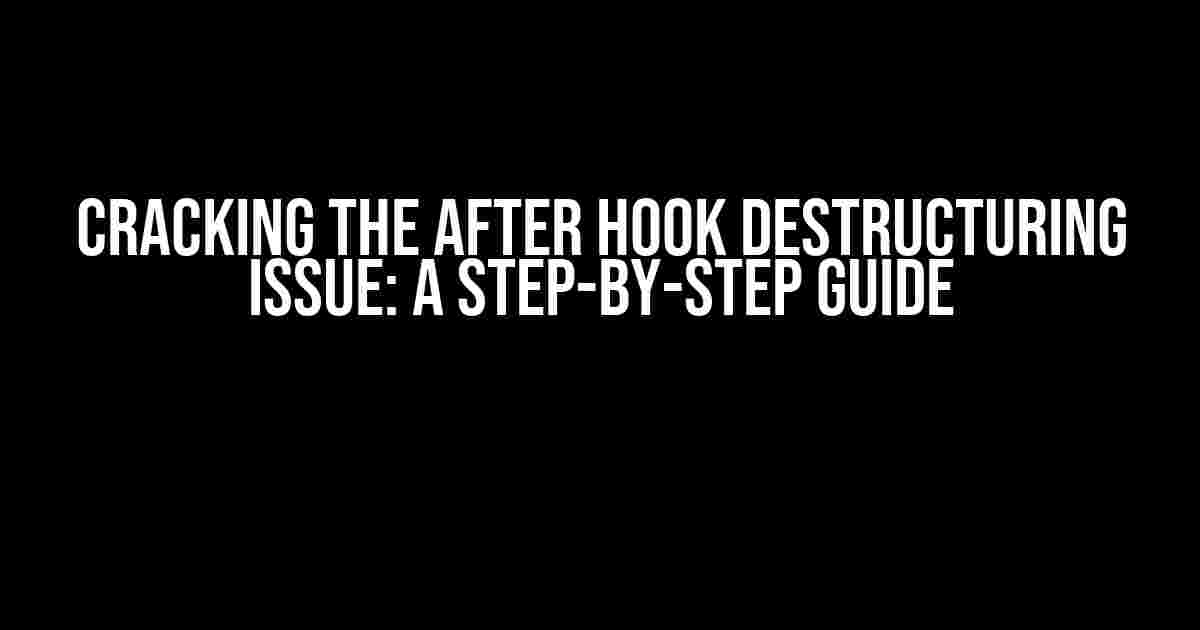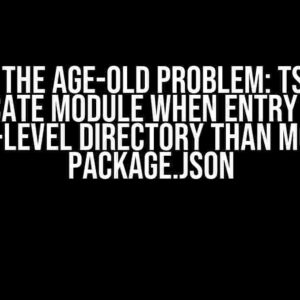Are you tired of wrestling with the after hook destructuring issue in your JavaScript code? Do you find yourself scratching your head, wondering why your code won’t work as expected? Fear not, dear developer! We’ve got you covered. In this comprehensive guide, we’ll delve into the depths of the after hook destructuring issue, explore its causes, and provide crystal-clear instructions to help you overcome this common pitfall.
What is the After Hook Destructuring Issue?
The after hook destructuring issue arises when you attempt to destructure an object or array within a hook function, specifically in the useEffect hook in React. This issue occurs because the hook function is called after the component has rendered, and the destructured variables are not yet available.
Symptoms of the After Hook Destructuring Issue
Here are some common symptoms that indicate you’re dealing with the after hook destructuring issue:
- Uncaught reference errors or undefined variables
- Unexpected behavior or output in your application
- Frequent re-renders or infinite loops
Causes of the After Hook Destructuring Issue
The primary cause of the after hook destructuring issue is the mismatch between the timing of hook function execution and the availability of destructured variables. Here are some scenarios that lead to this issue:
-
Destructuring within a hook function
useEffect(() => {
const { foo, bar } = props;
console.log(foo, bar); // Undefined or ReferenceError
}, []);
-
Destructuring an object or array returned by a hook
const { data, error, loading } = useFetchData();
useEffect(() => {
console.log(data, error, loading); // Undefined or ReferenceError
}, []);
Solutions to the After Hook Destructuring Issue
Don’t worry; we’ve got you covered! Here are some battle-tested solutions to overcome the after hook destructuring issue:
Solution 1: Avoid Destructuring within Hook Functions
A simple yet effective solution is to avoid destructuring within hook functions altogether. Instead, return the entire object or array and access the desired properties or values within the hook function.
useEffect(() => {
const propsCopy = props;
console.log(propsCopy.foo, propsCopy.bar);
}, []);
Solution 2: Use Optional Chaining
Optional chaining, introduced in ECMAScript 2020, allows you to access properties of an object or array without throwing an error if the property doesn’t exist. This can be particularly useful when working with hooks.
useEffect(() => {
const foo = props?.foo;
const bar = props?.bar;
console.log(foo, bar);
}, []);
Solution 3: Use the `useCallback` Hook
The useCallback hook allows you to memoize a function, ensuring it’s only recreated when the dependencies change. This can help alleviate the after hook destructuring issue.
const handleData = useCallback(() => {
const { data, error, loading } = useFetchData();
console.log(data, error, loading);
}, [useFetchData]);
useEffect(() => {
handleData();
}, [handleData]);
Solution 4: Split Hook Functions
Another approach is to split your hook functions into separate, smaller functions. This can help you avoid destructuring within hook functions and make your code more modular.
const handleData = () => {
const { data, error, loading } = useFetchData();
console.log(data, error, loading);
};
useEffect(() => {
handleData();
}, []);
Best Practices to Avoid the After Hook Destructuring Issue
To avoid the after hook destructuring issue altogether, follow these best practices:
- Avoid destructuring within hook functions
- Use optional chaining or default values to handle missing properties
- Memoize functions using
useCallbackto ensure dependency updates - Split hook functions into smaller, modular pieces
- Keep your hook functions simple and focused on a single task
Conclusion
In this comprehensive guide, we’ve explored the after hook destructuring issue, its causes, and provided actionable solutions to overcome it. By following the best practices outlined above and understanding the intricacies of hook functions, you’ll be well-equipped to tackle this common pitfall and write more robust, efficient code.
| Solution | Description |
|---|---|
| Avoid Destructuring within Hook Functions | Return the entire object or array and access properties within the hook function. |
| Use Optional Chaining | Access properties using optional chaining to avoid errors. |
| Use the `useCallback` Hook | Memoize a function to ensure recreation only when dependencies change. |
| Split Hook Functions | Break down hook functions into smaller, modular pieces. |
Remember, the key to overcoming the after hook destructuring issue is to understand the timing of hook function execution and the availability of destructured variables. By applying the solutions and best practices outlined in this guide, you'll be well on your way to writing robust, efficient code that avoids this common pitfall.
We hope this article has been informative and helpful in your quest to conquer the after hook destructuring issue. Happy coding!
Frequently Asked Question
If you’re facing issues with after hook destructuring, you’re not alone! Here are some frequently asked questions and answers to help you tackle the problem.
What is after hook destructuring, and why is it a problem?
After hook destructuring is an issue that occurs when a React hook is used after a destructuring operation. This can cause unexpected behavior, such as infinite loops or errors, because the hook is not being executed in the correct order. It’s a problem because it can be difficult to debug and can lead to unpredictable results in your application.
How do I know if I’m experiencing an after hook destructuring issue?
If you’re seeing unexpected behavior or errors in your application, and you’re using React hooks with destructuring, it’s possible that you’re experiencing an after hook destructuring issue. Look for symptoms such as infinite loops, incorrect state updates, or errors related to hook execution. If you’re unsure, try debugging your code or searching for similar issues online.
How can I avoid after hook destructuring issues?
To avoid after hook destructuring issues, make sure to execute React hooks before any destructuring operations. This ensures that the hooks are executed in the correct order and reduces the risk of unexpected behavior. You can also consider using a linter or code analysis tool to detect potential issues before they cause problems.
Can I use React hooks with destructuring in functional components?
Yes, you can use React hooks with destructuring in functional components, but you need to be careful to execute the hooks before any destructuring operations. This can be done by calling the hooks at the top level of your component, before any destructuring takes place. By following this approach, you can safely use React hooks with destructuring in functional components.
What tools can I use to help detect after hook destructuring issues?
There are several tools available to help detect after hook destructuring issues, including linters like ESLint, code analysis tools like CodeSandbox, and plugin like eslint-plugin-react-hooks. These tools can help identify potential issues in your code and provide warnings or errors to alert you to potential problems.



![The vh is returning different values in different components in the same screen [Closed] The vh is returning different values in different components in the same screen [Closed]](https://sibeal.hkhazo.biz.id/wp-content/uploads/sites/70/2024/07/the-vh-is-returning-different-values-in-different-components-in-the-same-screen-closed-with-text-300x300.jpg)